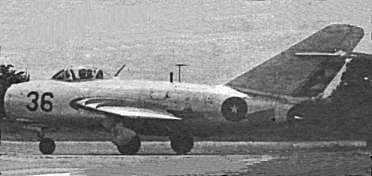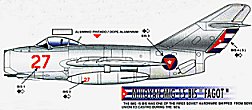
Index | Civil Aviation | Military Aviation | Equipment | Articles | People | Tanks | Military Forum | Military Encyclopedia
 This
famous fighter of the Korea War, begins to be projected in 1946 with aid
of the aeronautic studies captured in Germany and with the engine bought
in Great Britain Rolls-Royce Nene-I of 2,270 kg of pushing. Its
first flight was in December 30, 1947 with the original British engine,
that then is manufactured as "Klimov RD-45". The first MiG-15 manufactured
in series appears in December of 1948 and the first Regiments of MiG-15
are ready for 1949. At September 1949 does their first flight the
modification MiG-15bis, with a motor RD-45F, copy of the Rolls-Royce
Nene-II, of 2,700 kg of pushing. Its production begins in 1950.
The USSR manufactures 13,131 MiG-15 fighters of various types in 8 factories
from 1949 to 1959. Also they produce it for license Poland (1,000
monoplazas Lim-1/Lim-2 manufactured) and Czechoslovakia (1,473 monoplazas
Aero S102/S103 and 2,012 biplazas CS102), Chinese (Shenyang JJ-2/FT-2
biplazas). In all the total of MiG-15 produced reach more than 17,616 airplanes.
It served in the Air Force of 37 countries, and fights in numerous conflicts
as Korea (1950-1953), Hungary (1956), Medium East (1956, 1967), Yemen (1962-1967),
collisions Chinese-Taiwan, and others. This
famous fighter of the Korea War, begins to be projected in 1946 with aid
of the aeronautic studies captured in Germany and with the engine bought
in Great Britain Rolls-Royce Nene-I of 2,270 kg of pushing. Its
first flight was in December 30, 1947 with the original British engine,
that then is manufactured as "Klimov RD-45". The first MiG-15 manufactured
in series appears in December of 1948 and the first Regiments of MiG-15
are ready for 1949. At September 1949 does their first flight the
modification MiG-15bis, with a motor RD-45F, copy of the Rolls-Royce
Nene-II, of 2,700 kg of pushing. Its production begins in 1950.
The USSR manufactures 13,131 MiG-15 fighters of various types in 8 factories
from 1949 to 1959. Also they produce it for license Poland (1,000
monoplazas Lim-1/Lim-2 manufactured) and Czechoslovakia (1,473 monoplazas
Aero S102/S103 and 2,012 biplazas CS102), Chinese (Shenyang JJ-2/FT-2
biplazas). In all the total of MiG-15 produced reach more than 17,616 airplanes.
It served in the Air Force of 37 countries, and fights in numerous conflicts
as Korea (1950-1953), Hungary (1956), Medium East (1956, 1967), Yemen (1962-1967),
collisions Chinese-Taiwan, and others.
In spite of erroneous western reports, did not have still MiGs in Cuba neither pilot of such fighters during the Bay of Pigs battles of April of 1961. In reality the first MiG-15 arrive at Cuba at the end of May of 1961, a month after Bay of Pigs. They were 20 MiG-15bis and 4 MiG-15UTI. In Cuba were not primary versions MiG-15. With these equipment are formed the first two MiG-15bis Squadrons. The aircrafts for a third MiG-15bis Squadron arrives at end of 1961. In 1961 in total arrive 41 MiG-15bis, MiG-15Rbis, MiG-15UTI and MiG-19P. For their assembled and the pilot training in Cuba, at the beginning
of June of 1961 arrive more than one hundred of advisors from the USSR,
by the command of the Colonel Guenady Shadrin (Soviet Union Hero, and WWII
Ace with 14 victories of German aircrafts). These specialists begin to
assembling the MiG-15bis on June 6, 1961 San Antonio Air Base. To catch
experience, in this job participated also the Cubans technician, that still
worked in the old Sea Fury, T-33 and B-26.
The first Squadron is called "Carlos Ulloa", in honor of the Sea Fury nicaraguan pilot that dead in Bay of Pigs. The Leader of the MiG-15bis Squadron is appointed Enrique Carreras, as Second Leader the Captain Álvaro Prendes, the Leaders of Escuadrillas were the captains Alberto Fernández, Rafael del Pino and Douglas Rudd. To the end of 1961 already are ready two MiG-15bis Squadrons. In total the Russians form in Cuba in june-december of 1961 almost 50 pilots of MiG-15bis and MiG-19P. In July of 1961, a month after to be received the MiG-15bis, four of them participate in its first operation in cooperation with the grounds troops. That were exercises of air support to a Tank Battalion of T-34-85 in their offensive, in the fire poligon of Matanzas. The Leader of the Escuadrilla was Enrique Carreras, accompanied by Alvaro Prendes, Rafael del Pino and Douglas Rood. The MiG-15bis taken off from Varadero to attack the objective that simulated landing enemy forces. In November of 1961 with the following aircrafts was formed an recognition Squadron based in the aerodrome of Ciudad Libertad (old Columbia), formed by 10 MiG-15bis, MiG-15Rbis and 2 MiG-15UTI. Showing its preparation, 11 MiG-15bis fly in the parade air of January 2, 1962. Since 1960 also were being prepared Cubans MiG-15 pilots in Czechoslovakia,
USSR and Chinese. On October 11 the American SIGINT grasps the first
radio chat of MiG-15 pilots in Spanish from the air base of Trencin, Czechoslovakia.
The first 21 pilot graduates in Czechoslovakia arrive in March of 1962
for flying in the 3rd MiG-15bis Squadron, in this same year arrive others
74 MiG-15 pilots trainning in China. Great part of the candidates to MiGs
pilots that were sent to USSR and Czechoslovakia in 1960, were son of the
Socialist Party (Communist) leaders, that planned controlling the aviation
at the new government. Among them the son of the legendary communist Leaders
Jesús Menéndez (1911-1948) and Blas Roca (1908-1982) Carlos
Jesús Menéndez and Vladimiro Roca.
By the Cuban Missile Crisis in October of 1962, there
were 36 MiG-15bis and MiG-15Rbis in Cuba, in three Squadrons (besides the
MiG-15UTI). Avoiding to be destroyed in ground, these airplanes were dispersed
between several bases: San Antonio, Santa Clara, Camagüey, Holguín.
The MiG-15bis take off frequently trying to intercept the Americans RF-101
and RF-8 over Cuba. But by the lack of radars in the FAR, impeded that
the MiGs take off with the necessary time for an efficient intercepción
(the radares were in the hands of the Soviet troops). The MiG-15Rbis did
flights of reconnaissance by an possible American disembark. The future
Cuban Cosmonaut Arnaldo
Tamayo (today General) did 20 interception and reconnaissance
flights in the MiG-15bis and MiG-15Rbis from San Antonio, in the days of
the Crisis.
In the sixties were frequent the incursions of speed gunned botes from the Florida to Cuba, organizated by the CIA or the Cuban exiled. The CIA used "mothers ships" from where were sent the speed gunned botes for attacks or infiltrations of secret agents in the Cuban coasts. One of the more actives ships was the Rex, a 52 meters large anti submarine ship of the WWII. The ship was armed with a 57mm gun, a 40mm twin tube gun and 8 machine guns of 12,7mm. Against the Rex was prepared an ambush. In the operation would participate four Il-14R of reconnaissance with light bombs and two 250kg bombs, and four MiG-15bis. On October 21, 1963 the Rex approached at midnight to the San
Antonio Cape, in the Pinar del Río province, to disembark two speeds
boats with a team of 12 commands, in only one km from the coast. When the
commands approaching to the edge, they not received the agreed signal from
their men in ground . They understood that fell in an ambush, and opened
fire. Form the edge responded and was destroyed one of the boats. The second
boat fleed to the Rex, pursued by Cuban launches that appeared in the night.
But the Rex return in full speed. The Rex´s Captain Brooks orders
to leave to open sea, but then he returns to the coast, navigating fence
the coast to not be detected by the radars, in maneuver of deceit. Few
minutes later, in the same point where had been the Rex, appeared two Mi-4
helicopters, throwing light bombs. The assistant of the Captain of the
Rex counts: "So only we had passed the Cape, when I saw the lights of
a merchand ship. I wright now understood what was going to happenned. The
merchant entered to the illuminated zone, and the Cubans thought that these
were our ship. And they opened fire".
The Rex escaped toward Yucatán, Mexico, and when the Cubans understood
this, the MiG-15bis attacked it, damaging. But already the Rex was far
away, the MiG-15 were lack of fuel and munition, and return. Then two Cuban
coast guard, that pursued it until Cozumel, but not enter in the Mexican
waters. After two days of wait to the Rex, they retired. Although the Rex
could flee, since that night this type of activities of the CIA against
Cuba diminished drastically. According to Russian sources, that night some
of the MiG-15bis were piloted by Russian advisors. The USSR Government
wanted to punish them for the mistaken of ship, but the Government of Castro
assumed the responsibility, and they were forgiven. The U.S. Government
tried to present a protest by the attack of the ship "G.Louis". But Castro
advanced presenting on October 30 to the Cuban TV four prisoners from the
"Rex", commenting for hours the incident, and informing about the exact
location of the Rex ship in Key West. Begin the corresponding scandal in
the American press. That finishes the most famous incident with the Cubans
MiG-15.
In 1964 arrive the MiG-17, and then the
MiG-15bis of Santa Clara pass to Holguín. More MiG-15UTI were acquired
after the Missile Crisis until arrive several dozens of these
trainers. A MiG-15UTI was sent to Angola in 1975 as part
of the squadron of MiG-17. The MiG-15UTI had
a long career, trainning the following generations of pilots, until the
arrival of the Aero L-39C Albatros in 1981.
|





















